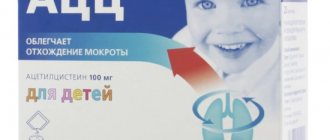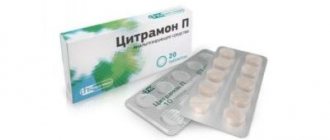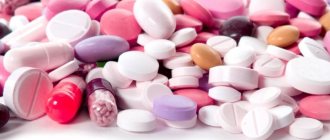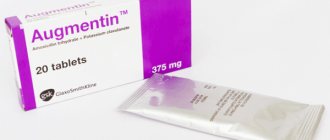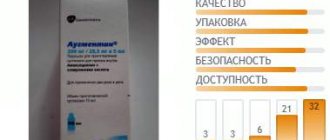Release forms and composition of the drug
This medicine is produced in the form of tablets for oral administration. Their active substance is nimesulide.
Nimesulid
Additional composition:
- MCC;
- corn starch;
- magnesium stearate;
- talc;
- food additive E551;
- food additive E951;
- povidone K-30;
- citric acid monohydrate;
- food additive E954 (sodium saccharin);
- coloring matter (yellow);
- flavor filler (mango).
All capsules are packaged in plastic blisters and packed in cardboard containers.
What to give preference: ointments or tablets?
Pain often disrupts the rhythm of life. To cope with this, you need to understand the mechanism of its action, and only after that start taking painkillers. The pain itself affects the soft tissue; to relieve it, you should take an NSAID.
Such medications are produced in the form of ointments, tablets, and powders.
- The ointment is prescribed for joint and spinal pain. The product is applied specifically to the affected area to eliminate swelling and inflammation.
- Medicines in the form of tablets and powders are prescribed for pain in the head, teeth, throat, etc.
It is difficult to decide which type of medication is better, since there is only one active ingredient. For joint ailments, the doctor usually prescribes an ointment for external use, as well as granules for oral use. The ointment is necessary for use specifically in the damaged area, so as not to harm the digestive, renal and liver systems. However, this only applies to joint and muscle pain.
Various dosage forms have been developed for convenient, effective and safe use of the drug. You should definitely consult your doctor before you start taking the medicine.
Pharmacological properties
The medication belongs to the group of non-steroidal anti-inflammatory drugs (non-narcotic in nature) with high analgesic properties.
The active substance suppresses the production of cyclooxygenase, which is involved in the formation of prostaglandins - mediators responsible for the development of inflammatory processes and pain.
The drug suppresses the activity of prostaglandins, including varieties that have a short duration of action. With a decrease in the level of prostaglandins, a decrease in the activity of prostanoid receptors is observed. This leads to a reduction in inflammatory manifestations and pain. The drug also suppresses the production of extracellular proteins responsible for the formation of cytokines.
The tablets prevent the destruction of cartilage tissue by suppressing the production of histamine and inhibiting the synthesis of interleukin 6. The medication also prevents the destruction of cartilage tissue and proteoglycans.
When interacting with glucocorticoid receptors, the drug leads to an increased anti-inflammatory effect. In this case, the active substance inhibits platelet aggregation.
Rules for taking Nimesulide
Nimesulide is taken orally (by mouth). The amount of the drug at one time should not exceed 100 mg - one tablet or the corresponding amount of suspension. Nimesulide contains excipients such as magnesium stearate, sodium lauryl sulfate, hydroxypropyl cellulose. All these substances are strong irritants of mucous tissues. If taken into an empty stomach, the drug can cause serious pain and burning in the abdomen, bloating, and diarrhea. Regular use of the drug on an empty stomach promotes the development of peptic ulcers. That is why Nimesulite can be drunk only after meals.
The frequency of administration is two times, with an interval between doses of at least 6 hours. If there are complications and particularly severe pain, the dose is increased. The maximum daily dose is 500 mg. Tablets and powder can be divided and taken in parts, increasing the frequency of administration. The minimum course duration is 15 days.
Nimesulide can also be prescribed for spinal stenosis, both during conventional treatment and after surgery.
About the causes of displacement of the lumbar vertebrae and treatment methods in this article.
Pharmacodynamics and pharmacokinetics
Nimesulide (for headaches, the drug is used only as prescribed by a specialist) has good absorption capacity and is quickly absorbed from the gastrointestinal tract. However, the rate of absorption of the drug may decrease when eating. The maximum level in the blood is reached after 1.5-2.5 hours.
The components of the drug interact with proteins (about 95%). In this case, the dosage taken does not affect the degree of binding. The active substance penetrates into the tissues of the female reproductive system, into places of inflammatory processes, as well as into the synovial fluid. The components penetrate the blood-brain barrier.
The medication undergoes metabolic processes in the liver and forms a metabolite (4-hydroxynimesulide), which has a similar effect. The half-life of the components of the drug ranges from 1.5 to 5 hours. The drug is administered primarily through the renal system (about 65%), as well as along with bile (about 35%).
In patients suffering from moderate renal failure, elderly patients, and children, the pharmacokinetics of the drug do not have clinically significant changes.
Nimesulide or Nise – which is better?
Manufacturer: Dr.
Reddy,s Laboratories LTD (India) Release form: tablets, gel, powder for solution
Active ingredient: nimesulide
Nimesulide and its analog Nise have the same active ingredient and equivalent indications for use. They are recommended for inflammatory processes accompanied by pain of varying intensity due to pathology of the joint-muscular system of the body. These means have a difference and differ:
- Release form. Nise in the form of a powder for preparing a solution gives a quick effect in relieving painful symptoms (after 1–2 hours). The drug can also be recommended in tablets or gel form for external use.
- Cost. The price of Nimesulide tablets is 2 times less compared to Nise tablets.
According to patient reviews, both drugs show good therapeutic results. But the effect of Nise was noted to be more effective, since some patients who took Nimesulide experienced side effects from the digestive system.
Indications for use
The medicine is used for the development of pain and inflammatory processes caused by the development of internal diseases.
Indications:
- relapses of gout;
- rheumatoid or psoriatic arthritis;
- radicular osteochondrosis;
- inflammatory processes in the area of the ligamentous apparatus, tendons;
- myalgia of various origins;
- various forms of bursitis, including soft tissue pathology;
- presence of osteoarthritis;
- ankylosing spondylitis;
- pain caused by various factors - toothache, migraines, injuries and injuries, lumbar ischialgia, rehabilitation after surgery, arthralgia.
Tablets are prescribed only after preliminary research and with a confirmed diagnosis.
Advantages and disadvantages
Nimesulide is characterized by a large number of advantages, due to which this medicine is often prescribed to relieve toothache.
These include:
- Nimesulide is characterized by a large number of advantages, due to which this medicine is often prescribed to relieve toothache
Pronounced effect;
- Addressing the cause of pain – inflammation, rather than eliminating the symptom;
- Efficiency in a wide range of pathologies;
- Long lasting;
- Low likelihood of side effects if dosages are followed;
- Availability.
Despite the listed advantages, the medicine is also characterized by a number of disadvantages.
These include:
- Prohibited for use by pregnant women and children;
- Not intended for long-term use;
- Possibility of addiction;
- Liver toxicity;
- Potential possibility of overdose and poisoning.
Important to remember! Nimesulide is used to relieve acute toothache. Constant treatment will not eliminate the cause of this pathology, and therefore a complete cure requires the help of a dentist.
Contraindications
Nimesulide (a remedy for headaches should be used only in the absence of contraindications) has some restrictions on its prescription.
Contraindications:
- intolerance to the composition of the product;
- the presence of bleeding in the stomach in the active phase;
- bronchial asthma in combination with polyposis;
- various forms of bleeding;
- the presence of erosions or ulcers in the area of the mucous membrane of the stomach or duodenum;
- intestinal pathologies caused by the development of inflammatory processes (in an acute form);
- disorders of blood clotting (hemophilia);
- liver failure, including severe functional disorders of the organ;
- heart failure (in the stage of decompensation);
- any risks of developing toxic liver damage caused by taking the drug;
- alcohol dependence or drug addiction;
- severe kidney failure;
- rehabilitation after coronary bypass surgery;
- the period of bearing or feeding a child;
- childhood.
Before using the medicine, it is necessary to undergo additional examinations to confirm or exclude the presence of contraindications.
Comparative assessment of the effect of nimesulide on the upper gastrointestinal tract
Nimesulide is one of the most popular representatives of the group of non-steroidal anti-inflammatory drugs (NSAIDs) in Russia. This medicine has a reputation in our country as an effective and fairly safe analgesic and is widely used in various branches of medicine (primarily in rheumatology, neurology and traumatology), where there is a need to combat acute or chronic pain [1–3].
One of the main features of the Russian experience with nimesulide is its frequent use in long courses. In most countries of the world, nimesulide is considered primarily as an urgent pain reliever; Given regulatory restrictions, it is prescribed for short periods only, usually less than two weeks [4]. In our country, on the contrary, nimesulide is often recommended for patients with chronic diseases such as osteoarthritis (OA), rheumatoid arthritis (RA) and ankylosing spondylitis (AS). With this pathology, the total period of taking nimesulide in Russian patients can reach many months and even years.
This practice provides a lot of material for assessing the advantages and disadvantages of a drug, first of all, its safety.
As is known, the main problem with NSAIDs is the risk of side effects from the gastrointestinal tract (GIT) and cardiovascular system [5, 6]. At the same time, the main advantage of nimesulide is considered to be good gastrointestinal tolerability, which, in fact, determines the main advantage of this drug in comparison with many other NSAIDs [1–4, 7].
However, there is relatively little clear evidence supporting the low risk of serious gastrointestinal complications (such as bleeding and clinically significant ulcers) with nimesulide. There are only a few studies that specifically studied the frequency of such dangerous side effects, and individual studies organized in accordance with the strict modern criteria of “evidence-based medicine” - double-blind, randomized and controlled [7–9].
In this case, the analysis of the frequency of complications that are observed in real clinical practice becomes of great importance. So, to the clinic of the Federal State Budgetary Institution NIIR named after. V. A. Nasonova RAMS annually admits for inpatient treatment a large number of patients with various rheumatic diseases (RD) - rheumatoid arthritis (RA), osteoarthritis (OA), seronegative spondyloarthritis (SSA), etc., who have been taking NSAIDs for a long time, including nimesulide. This institution has its own endoscopy room, the main focus of which is identifying pathologies of the upper gastrointestinal tract. The results of examination of patients with RD, which are in the archives of the endoscopy room, make it possible to obtain sufficiently large material to assess the frequency of pathology of the upper gastrointestinal tract that occurs while taking NSAIDs.
The purpose of this study was to evaluate the comparative frequency and nature of changes in the upper gastrointestinal tract in patients with RD who regularly took nimesulide.
Material and research methods
We conducted a retrospective analysis of the results of all endoscopic examinations of the upper gastrointestinal tract (esophagogastroduodenoscopy (EGD)) performed during the period 2011–2013. at the clinic of the Federal State Budgetary Institution NIIR named after. V. A. Nasonova of the Russian Academy of Medical Sciences for patients with RD who received nimesulide for at least 1 month before this procedure. The results of endoscopy performed during the same period in all patients who received other non-selective NSAIDs for at least a month were used as a control.
All patients were referred for endoscopic examination by their attending physicians due to the presence of certain indications: to exclude pathology of the upper gastrointestinal tract due to the presence of symptoms of gastroesophageal reflux, gastralgia or dyspepsia, a history of gastric or duodenal ulcers, to search for the source of anemia , for cancer screening, if necessary, taking a biopsy of the mucous membrane of the duodenum for amyloid, etc.
The criteria for selecting patients for analysis were age over 18 years and the fact of regular use of NSAIDs recorded in the medical documentation for at least 1 month before the endoscopy.
The analysis did not include endoscopic data in patients with systemic RD, in which gastrointestinal lesions may be a manifestation of visceral pathology: systemic scleroderma, poly/dermatomyositis, systemic lupus erythematosus, Behçet's disease and systemic vasculitis. The control group also excluded patients using meloxicam, celecoxib, and etoricoxib; took part (at the time of endoscopy) in clinical studies that studied the safety of NSAIDs; aimed at endoscopy to monitor the results of a course of treatment for gastric and/or duodenal ulcers, or erosive esophagitis.
In total, over three years, EGD was performed in 1048 patients who met the selection criteria and took nimesulide, as well as 816 patients who used other non-selective NSAIDs. These drugs were mainly diclofenac, ketoprofen, indomethacin, aceclofenac and ibuprofen; only a few patients regularly took piroxicam, tenoxicam, ketorolac or metamizole.
Clinical characteristics of patients in the study groups are presented in the table.
As you can see, most of the patients were middle-aged women suffering from rheumatoid arthritis. In general, the study groups were comparable; however, in the control group there were significantly more patients suffering from SSA (mainly ankylosing spondylitis). This fact explains the higher proportion of males in the control group. It should be noted that patients taking nimesulide more often had a history of ulcers, more often took glucocorticoids (GCs) and significantly less often took proton pump inhibitors (PPIs).
When analyzing the results of endoscopy, we took into account the detection of erosions, which meant a superficial defect of the mucous membrane that had no visible depth, and ulcers—local damage to the wall ≥ 5 mm, which had a visible depth. If fewer than 10 erosions were detected, they were described as “single”, and if ≥ 10 were detected, they were described as “multiple.”
The electronic database was created using Microsoft Office Excel 2007; statistical analysis was carried out using SPSS 10.0. The digital values given in the article are presented in the form M ± m. To assess the significance of differences in quantitative parameters, Student's t-test was used; for qualitative parameters, χ2 or Fisher's exact test was used.
results
The total number of patients with erosions or ulcers in group 1 was 244 (23.3%), in group 2 - 272 (33.3%), p < 0.001 (Fig.). Moreover, single erosions were more common in patients taking nimesulide compared to those receiving other NSAIDs. But more serious pathology - multiple erosions and especially ulcers - were detected much less frequently in group 1. Thus, the total number of patients who developed a stomach and/or duodenal ulcer while taking nimesulide was 46 (4.4%), and in the control group - 119 (14.6%).
Moreover, the largest number of ulcers in patients of group 2 was observed in those who received indomethacin, ketoprofen and diclofenac - 24.6%, 15.4% and 15.0%, respectively. This pathology was detected significantly less frequently when taking ibuprofen - 6.7% and aceclofenac - 3.6%. Also, one ulcer was identified in a patient who used piroxicam (among the people we examined, only three took this drug).
We analyzed the influence of the main risk factors for NSAID gastropathy—peptic ulcer history, NDA use, and older age (>65 years) on the incidence of gastric and/or duodenal ulcers.
It turned out that ulcers were detected significantly more often in people with a history of ulcers. Thus, in group 1, in patients with this risk factor, the total incidence of gastric and/or duodenal ulcers was 11.5%, without - 3.1% (p < 0.001). A similar situation was observed in the control group: 10.5% and 37.5%, respectively (p < 0.001).
Taking Aspirin significantly increased the risk of developing ulcers - in group 1, their frequency was 16.7% for those taking NDA, and 3.6% for those not taking it (p < 0.001). In group 2, the same pattern was noted: ulcers were detected in 25.0% of those who took and 14.3% of those who did not take NDA (p = 0.002).
Older age was also associated with a higher incidence of ulcers, but only in patients in group 1. Thus, in patients > 65 years old taking nimesulide, the incidence of ulcers was 9.9%, in younger patients - 3.5% (p < 0.001) . However, this pattern was not observed in the control group: the frequency of ulcers was 14.8% and 14.3%, respectively.
Taking GCs and bisphosphonates did not affect the incidence of ulcers. Thus, in group 1, in patients receiving GC, ulcers were detected in 4.1%; among those who did not take it - 4.6% (p = 0.742). In bisphosphonate users and non-users, the incidence of ulcers was 6.6% and 4.3% (p = 0.487). The same results were obtained in group 2: 16.7% and 13.9% (p = 0.214) for GCs and 11.8% and 14.6% (p = 0.605) for bisphosphonates.
It should be noted that in patients who did not have the main risk factors (ulcer history, NDA use and age > 65 years), the incidence of ulcers was much lower than in the overall group. However, ulcers were detected significantly more often in group 2. Thus, in group 1 in 752 patients without risk factors, ulcers were detected in only 16 (2.1%), and in the control group - in 48 of 568 (8.5% ), p < 0.001.
We analyzed the effect of gastroprotective therapy (regular use of PPIs) on the incidence of ulcers. Interestingly, taking these drugs was associated with more frequent detection of gastrointestinal pathology. Moreover, if in group 1 the difference was not significant - the frequency of ulcers was 5.7% for those receiving PPIs and 4.3% for those not taking these drugs (p = 0.228), then in group 2 it was very significant - 33.3% and 12.2 % respectively, p < 0.001. On the other hand, it should be taken into account that PPIs were used significantly more often in patients who had certain risk factors for NSAID gastropathy (ulcer history, use of non-steroidal anti-inflammatory drugs and age > 65 years). Thus, the use of PPIs was noted in 16.2% of patients from group 1 who had the above risk factors, and only in 5.3% of those who did not; similarly, in group 2, 26.2% and 5.6% received these drugs.
A separate object of our analysis was the assessment of the frequency of esophageal pathology. Erosive esophagitis was detected only in a small number of patients (in comparison with pathology of the stomach and duodenum). However, erosive esophagitis was significantly less frequently detected in patients in group 1 - in 15 (1.4%), compared to 26 (3.1%) in group 2, p = 0.03.
Risk factors such as older age and GC were not associated with a higher incidence of esophageal pathology in either group 1 or group 2. At the same time, erosive esophagitis was significantly more often detected in patients in group 2 who received LDA (but not in group 1). Taking bisphosphonates turned out to be a clearly important risk factor - in both group 1 and group 2, when using these drugs, erosive esophagitis was detected significantly more often (p < 0.05).
The discussion of the results
As can be seen, serious changes in the upper gastrointestinal tract occurred significantly less frequently in patients with RD who regularly took nimesulide, compared to patients who used other non-selective NSAIDs. This fact can be considered as additional confirmation of the good tolerability of nimesulide. While taking diclofenac, ketoprofen and indomethacin, stomach and/or duodenal ulcers were observed more than 3 times more often. It should be taken into account that the risk of developing NSAID gastropathy in patients receiving nimesulide was higher than in the control group: more of them had a history of ulcers, they more often used NDAs and were less likely to receive effective gastroprotectors (PPIs). This situation is most likely due to the fact that the attending physicians perceived nimesulide as a safer drug than other NSAIDs.
Of course, when talking about the risk of NSAID-associated complications from the gastrointestinal tract, we first need to take into account the possibility of developing a life-threatening pathology - bleeding and perforation. However, the appearance of gastric or duodenal ulcers (including asymptomatic ones) while taking NSAIDs is traditionally considered as the most important “surrogate marker” of dangerous complications. This is indicated, in particular, by the famous British researcher A. Moore in his works devoted to this issue [10, 11].
Indeed, according to modern concepts, the development of NSAID-induced ulcers is determined by the same pathogenetic mechanism (peptic damage against the background of a significant decrease in the protective potential of the mucous membrane associated with a decrease in prostaglandin production) as the development of bleeding [10, 11]. Moreover, it is well known that the main source of bleeding from the upper gastrointestinal tract is ulcers [12–14]. Moreover, the risk of developing ulcers and bleeding is clearly associated with general risk factors: older age, a history of ulcers and concomitant use of medications that reduce blood clotting (low doses of Aspirin, etc.) [12–14].
It should be noted that asymptomatic ulcers occur quite often while taking NSAIDs. According to a number of clinical trials, when using non-selective NSAIDs, their incidence can reach 15–25% [15, 16]. However, we diagnosed ulcers in patients who were referred for EGD due to the presence of specific indications - symptoms indicating the possibility of gastrointestinal lesions, or obvious risk factors. Therefore, the pathology we identified appears to be more serious than “asymptomatic” ulcers identified during total endoscopic control in scientific studies.
Our data confirms the results of Russian scientists who studied the safety of nimesulide. Previously, we presented a review of 21 domestic open-label studies (n = 2116), in which the effectiveness and tolerability of nimesulide were compared with other NSAIDs, paracetamol, tramadol and homeopathic medicines. The total number of gastrointestinal complications when using nimesulide turned out to be significantly lower than when taking other drugs: dyspepsia developed in 9.1% and 10.8%; stomach and/or duodenal ulcers in 1.6% and 10.6% (p < 0.001); discontinuation of therapy due to complications was required in 1.4% and 2.5% of patients (p < 0.05) [17].
There are few well-designed safety studies of nimesulide based on endoscopic monitoring [7, 18, 19]. Among them, a comparison of nimesulide 200 mg/day and naproxen 1000 mg/day, conducted in 71 volunteers, should be highlighted. After 30 days of taking these drugs, only one case of the development of multiple erosions was noted in the nimesulide group. At the same time, in the control group, multiple erosions developed in 44%, and ulcers in 16% [19].
As noted above, the risk of developing dangerous complications, primarily gastrointestinal bleeding, is of fundamental importance for assessing the safety of NSAIDs. One method for studying this parameter is population-based case-control studies.
It must be said that with regard to nimesulide, similar studies show ambiguous results. Thus, in a large-scale study by Finnish scientists (analysis of 9191 episodes of gastrointestinal bleeding and ulcers), nimesulide demonstrated a fairly high risk of complications: odds ratio (OR) 4.0; for diclofenac – 3.7 [20].
Other results were shown in the work of Italian scientists J. Laporte et al., who compared the use of NSAIDs in 2813 patients who had an episode of gastrointestinal bleeding and 7193 individuals without this complication as a control. Nimesulide turned out to be safer than many other NSAIDs: the OR for it was 3.2, for diclofenac 3.7, meloxicam 5.7, and rofecoxib 7.2 [21].
Data from more recent work by J. Castellsague et al speak in favor of nimesulide. The authors assessed the risk of serious gastrointestinal complications in one region of Italy, where 588,827 patients taking NSAIDs were recorded and over the period 2001–2008. There were 3031 episodes of gastrointestinal bleeding or clinically significant ulcers. Nimesulide showed a low risk of these complications, corresponding to a similar indicator for the selective NSAIDs celecoxib and rofecoxib [22].
Our study once again confirms the fundamental importance of considering risk factors before prescribing NSAIDs [23]. According to the data obtained, the majority of cases of development of gastric and/or duodenal ulcers were observed in elderly people, with a history of ulcers or during concomitant use of NDAs. The incidence of ulcers in individuals with any of the three risk factors listed above was 3–5 times higher than in patients who did not have any of them. Moreover, this pattern was observed both when using nimesulide and control drugs.
An interesting and relatively little-studied issue of the safety of NSAIDs is the assessment of their comparative effects on the esophagus [24, 25]. It is well known that taking these drugs increases the risk of developing erosive esophagitis, bleeding and peptic stricture, especially in the presence of gastroesophageal reflux disease [26–28]. However, it is still unclear whether selective NSAIDs are better tolerated in the esophagus [29]. Thus, according to the MEDAL study (18-month comparison of etoricoxib and diclofenac, n = 34,701), etoricoxib, the most selective NSAID, did not demonstrate an advantage in this indicator compared to the control drug. The rate of discontinuation of therapy due to problems related to the esophagus was practically the same and was 0.38 and 0.41/100 patient-years, respectively (p = 0.718) [30].
Our data showed a lower incidence of erosive esophagitis in patients receiving nimesulide. However, a relatively small number of observations does not allow us to draw serious conclusions about the advantage of nimesulide, in comparison with other non-selective NSAIDs, regarding the risk of developing esophageal pathology. Further research is required to explore this issue.
Literature
- Nasonov E. L. Efficacy and tolerability of a non-steroidal anti-inflammatory drug. Nimesulide: new data // Russian Medical Journal. 2001, no. 15, 6–8.
- Chichasova N.V., Imametdinova G.R., Igolkina E.V., Nasonov E.L. Nise in the treatment of chronic joint diseases // Russian Medical Journal. 2013, no. 23, 1177–1185.
- Barskova V.G. What does the study of sales statistics of non-steroidal anti-inflammatory drugs in the Russian Federation give us? // Modern rheumatol. 2011; 3:68–74.
- Mattia C., Ciarcia S., Muhindo A., Coluzzi F. Nimesulide: 25 years later // Minerva Med. 2010, 101(4): 285–293.
- Crofford L. Use of NSAIDs in treating patients with arthritis // Arthritis Res Ther. 2013; 15, Suppl 3: S2. doi: 10.1186/ar4174. Epub 2013 Jul 24.
- Lanas A., Garcia-Tell G., Armada B., Oteo-Alvaro A. Prescription patterns and appropriateness of NSAID therapy according to gastrointestinal risk and cardiovascular history in patients with diagnoses of osteoarthritis // BMC Medicine. 2011, 9: 38. doi: 10.1186/1741–7015–9-38.
- Rainsford K. Nimesulide — a multifactorial approach to inflammation and pain: scientific and clinical consensus // Curr Med Res Opin. 2006, 22(6), 1161–1170.
- Huskisson E., Macciocchi A., Rahlfs V. et al. Nimesulide versus diclofenac in the treatment of osteoarthritis of the hip or knee: an active controlled equivalence study // Curr Ther Res. 1999, 60, 253–265.
- Kriegel W., Korff K., Ehrlich J. et al. Double-blind study comparing the long-term efficacy of the COX-2 inhibitor nimesulide and naproxen in patients with osteoarthritis // Int J Clin Pract. 2001, 55(8):510–514.
- Moore RA Endoscopic ulcers as a surrogate marker of NSAID-induced mucosal damage // Arthritis Research & Therapy. 2013, 15 (Suppl 3): S4. doi:10.1186/ar4176.
- Moore A., Bjarnason I., Cryer B. et al. Evidence for endoscopic ulcers as meaningful surrogate endpoint for clinically significant upper gastrointestinal harm // Clin Gastroenterol Hepatol. 2009, Nov; 7 (11): 1156–1163. doi: 10.1016/j.cgh.2009.03.032. Epub 2009 Apr 9.
- Gelfand B. R., Protsenko D. N., Babayants A. V., Karateev A. E. Acute bleeding from the upper gastrointestinal tract: from epidemiology to the formation of the concept of conservative therapy // Infections in surgery. 2013, no. 4, 11–17.
- Brooks J., Warburton R., Beales I. Prevention of upper gastrointestinal haemorrhage: current controversies and clinical guidance // Ther Adv Chronic Dis. 2013, Sep; 4 (5): 206–222. doi: 10.1177/2040622313492188.
- Laine L., Curtis S., Cryer B. et al. Risk factors for NSAID-associated upper GI clinical events in a long-term prospective study of 34,701 arthritis patients // Aliment Pharmacol Ther. 2010, Nov; 32 (10): 1240–1248. doi: 10.1111/j.1365–2036.2010.04465.x. Epub 2010 Sep 23.
- Emery P., Zeidler H., Kvien T. et al. Celecoxib versus diclofenac in long-term management of rheumatoid arthritis: randomized double-blind comparison // Lancet. 1999; 354:2106–2111.
- Hunt R., Harper S., Watson D. et al. The gastrointestinal safety of the COX-2 selective inhibitor etoricoxib assessed by both endoscopy and analysis of upper gastrointestinal events // Am J Gastroenterol. 2003, 98(8):1725–1733.
- Karateev A.E. Russian experience in using nimesulide: review of clinical trials // Consilium medicum. 2011, 13 (9), 89–95.
- Porto A., Almeida H., Cunha M., Macciocchi A. Double-blind study evaluating by endoscopy the tolerance of nimesulide and diclofenac on the gastric mucosa in osteoarthritic patients // Eur J Rheumatol Inflamm. 1994; 14 (4): 33–38.
- Bjarnason I., Thjodleifsson B. Gastrointestinal toxicity of non-steroidal anti-inflammatory drugs: the effect of nimesulide compared with naproxen on the human gastrointestinal tract // Rheumatology (Oxford). 1999. May; 38, Suppl 1: 24–32.
- Helin-Salmivaara A., Saarelainen S., Gronroos J. et al. Risk of upper gastrointestinal events with the use of various NSAIDs: A case-control study in a general population // Scan J Gastroenterol. 2007; 42:923–932.
- Laporte J., Ibanez L., Vidal X. et al. Upper gastrointestinal bleeding associated with the use of NSAIDs: newer versus older agents // Drug Safety. 2004, 27, 411–420.
- Castellsague J., Pisa F., Rosolen V. et al. Risk of upper gastrointestinal complications in a cohort of users of nimesulide and other nonsteroidal anti-inflammatory drugs in Friuli Venezia Giulia, Italy // Pharmacoepidemiol Drug Saf. 2013. Apr; 22 (4): 365–75. doi: 10.1002/pds.3385.
- Burmester G., Lanas A., Biasucci L. et al. The appropriate use of non-steroidal anti-inflammatory drugs in rheumatic disease: opinions of a multidisciplinary European expert panel // Ann Rheum Dis. 2011, 70(5): 818–822.
- Parfitt J., Driman D. Pathological effects of drugs on the gastrointestinal tract: a review // Hum Pathol. 2007 Apr; 38(4):527–536.
- Abitbol V., Chaussade S. Are dyspepsia or gastroesophageal reflux predictive of serious digestive events during treatment with NSAIDs? How should they be treated? // Presse Med. 2003, 32, 53–55.
- Yasuda H., Yamada M., Endo Y., Inoue K., Yoshiba M. Acute necrotizing esophagitis: role of nonsteroidal anti-inflammatory drugs // J Gastroenterol. 2006, 41, 193–197.
- Avidan B., Sonnenberg A., Schnell T., Sontag S. Risk factors for erosive reflux esophagitis: a case-control study // Am J Gastroenterol. 2001, 96, 41–46.
- Avidan B., Sonnenberg A., Schnell T. et al. Risk factors of oesophagitis in arthritic patients // Eur J Gastroenterol Hepatol. 2001, 13, 1095–1099.
- Mantry P., Shah A., Sundaram U. Celecoxib associated esophagitis: review of gastrointestinal side effects from cox-2 inhibitors // J Clin Gastroenterol. 2003, 37, 61–63.
- Laine L., Curtis S., Cryer B. et al. Assessment of upper gastrointestinal safety of etoricoxib and diclofenac in patients with osteoarthritis and rheumatoid arthritis in the multinational etoricoxib and diclofenac arthritis long-term (MEDAL) program: a randomized comparison // Lancet. 2007, 369, 465–473.
A. E. Karateev, Doctor of Medical Sciences, Professor
FSBI NIIR named after. V. A. Nasonova RAMS, Moscow
Contact Information
Side effects
The medicine may lead to the development of negative reactions associated with the action of the active component or the patient's condition.
Side effects:
- Skin manifestations: itching, rashes, hyperhidrosis, development of dermatitis or erythema. In rare cases, angioedema or swelling of the face, urticaria, Stevens-Johnson syndrome, and Lyell's disease may occur.
- Disorders in the central nervous system: development of dizziness, feelings of fear, nightmares, increased nervousness. In rare cases, taking pills can cause drowsiness, migraine pain, and also lead to the development of encephalopathy.
- Visual disturbances: blurred vision.
- Malfunctions of the cardiovascular system: palpitations, increased blood pressure, hot flashes, increased heart rate.
- Respiratory disorders: development of shortness of breath or bronchospasm, relapse of bronchial asthma.
- Digestive system disorders: nausea and vomiting, diarrhea, constipation, flatulence. It is extremely rare to develop dyspepsia, pain syndrome, bleeding, stomatitis, and ulcers in the mucous membrane of the stomach and duodenum.
- Liver disorders: increased concentration of liver enzymes, cholestasis, hepatitis, jaundice.
- Renal and urinary systems: problems with urination, increased potassium concentration, kidney failure, nephritis, oliguria.
- General violations: development of swelling, general malaise, asthenic conditions, decreased body temperature.
If adverse reactions develop, including symptoms not listed, you should immediately contact your doctor.
Nimesulide granules
The drug in powder form has some advantage - it is quickly absorbed by the body, which allows you to quickly cure the disease. Initially, the powder is diluted with water in an amount of 100 ml (at any temperature) and immediately drunk. The daily dose of this medicine is 200 mg. The medication is not used to treat children under 12 years of age.
The annotation for the granules describes the following side effects:
- tachycardia, possible bleeding;
- in rare cases, rashes, itching, and hyperemia appear;
- possible decrease in visual function;
- kidney and liver diseases.
According to statistics, the occurrence of side effects is rare, only when the medicine is used incorrectly (exceeding the dose, prolonged use, etc.).
Nimesulide in powder form has some limitations for use. These include:
- pregnancy and lactation period;
- hypersensitivity in older people;
- Diabetics should consult a doctor before taking the medicine as it contains sugar;
- For kidney and liver diseases, you should use the medication with caution, since it can affect an existing disease or lead to the development of a new one.
The medicine is easily absorbed by the stomach, it accumulates in the plasma and begins to act after 2-3 hours.
This form of the drug is not recommended for children because it has adverse reactions.
This drug is available in the form of light yellow granules with a specific aroma; the aqueous solution has the same odor and whitish color. When the question arises about whether to treat with tablets or powder, the doctor gives preference to granules, since the result from their influence is observed more quickly.
Overdose
If prescribed dosages are exceeded, negative symptoms may develop.
Overdose:
- increased drowsiness;
- apathy;
- nausea and vomiting;
- pain in the stomach area;
- formation of gastric bleeding;
- increased blood pressure;
- kidney failure (acute development);
- depression of respiratory functions;
- coma;
- anaphylactic reactions.
If signs of overdose develop, you should consult a doctor for symptomatic therapy. The medicine does not have a specific antidote. It is independently recommended to induce vomiting and take sorbent drugs.
Use of the drug for back pain
Nimesulide is a powerful antispasmodic and analgesic agent, the effect of which lasts quite a long time after administration. Of course, it all depends on the severity of the disease and the painful syndrome. The initial dose of the drug is 200 mg per day, that is, 2 tablets, or 2 sachets. Take twice a day, morning and evening, immediately after meals. The recommended interval between use is 7 – 8 hours.
In case of complex injuries of the back and spine or in severe pathological course of the disease (rheumatoid arthritis, deformation of the cervical vertebrae), accompanied by prolonged pain symptoms, the dose of the drug can be increased to 5 doses per day. The maximum dosage for an adult (over 16 years of age) is 500 mg per day. For children, the dosage should not exceed 200 mg. Nimesulide should be taken strictly under the supervision of the attending physician, who will be able to determine the optimal dosage to alleviate pain symptoms. As soon as progress in treatment is noticeable, the dose of the drug is gradually reduced until complete failure.
special instructions
Nimesulide can be used both internally and topically. However, it is recommended to use oral forms of the drug as a treatment for headaches.
The drug is prescribed with extreme caution to elderly patients, as well as to patients suffering from gastric bleeding, since the risk of bleeding in the stomach and duodenum is high. In this regard, it is recommended to start treatment with reduced dosages.
In patients with functional bleeding disorders or taking medications that affect blood clotting, therapy should be carried out under the supervision of a specialist. If these symptoms develop, treatment should be stopped.
When taking tablets for more than 14 days, it is necessary to undergo examinations for the level of liver enzymes. If negative reactions associated with liver damage occur, further use of the medicine should be discontinued.
Monitoring by the attending physician is required when prescribing the drug to patients with impaired renal function. If necessary, the drug should be discontinued.
Elderly patients with hypersensitivity to non-steroidal anti-inflammatory drugs require constant monitoring of liver, kidney and heart functions.
To avoid the development of side effects, it is recommended to start treatment with minimal doses and short courses.
The effect of the drug on the human psyche has not been studied. Therefore, it is recommended to be careful when driving a car or performing other work that requires high psychomotor reactions.
Rules for using Nimesulide
The annotation for the drug describes certain precautions during treatment. People with stomach diseases should take this medicine very carefully, since the active component can lead to an exacerbation of an existing illness.
When taking this medication for more than 14 days, it is recommended to have your kidneys examined because it may affect renal transaminase functions. If renal function is impaired, nausea, vomiting, abdominal pain, and changes in the color of urine may occur. In such a situation, you should immediately stop taking Nimesulide in the form of tablets or granules and consult a doctor. It should be noted that the drug is excreted through the kidneys; if there is a disorder in the renal system, the dose of the drug should be reduced. It is imperative to notify the doctor about existing diseases, since Nimesulide is a rather strong drug.
People with disorders of the heart and blood vessels need to take this medicine conscientiously, as it can worsen the patient’s well-being. In this case, you should stop taking the pills and consult a specialist. When using Nimesulide, you should stop taking painkillers and other medications belonging to the NSAID group.
Regarding the negative impact on the digestive system, the occurrence of problems can be observed:
- If a person has diseases in the gastrointestinal tract.
- If the dosage of the medicine is exceeded.
If the patient has diabetes mellitus, you should also carefully use the medication due to the substances it contains that are harmful to diabetics.
There are certain requirements for the use of Nimesulide. Since the effect of the drug on driving has not yet been studied, you should drive carefully during the entire course of therapy.
Drug interactions
The granules may interact with other medications.
Groups of drugs and their interactions:
- Glucocorticosteroids. Increased risk of stomach ulcers and bleeding.
- Drugs that suppress platelets and serotonin reuptake inhibitors. Increased risk of bleeding in the stomach.
- Anticoagulants. Increased effect of anticoagulants. Increased risk of bleeding and bleeding disorders. Careful monitoring of blood clotting functions is required.
- Diuretics. The effect of diuretics may be reduced. The excretion of sodium and potassium from the body may decrease. Caution should be exercised when taking the tablets and furosemide together in patients suffering from renal or cardiac impairment.
- Drugs that suppress the action of angiotensin-converting enzyme and angiotensin 2 receptor antagonists. The effect of this group of drugs may be reduced. When these medications and tablets are used together in patients with mild to moderate renal impairment, the risk of developing renal failure may increase. This combination of medications is used extremely carefully, especially in elderly patients. In this case, it is necessary to consume a sufficient amount of fluid and constantly monitor kidney function.
- Preparations containing lithium. An increase in the concentration of lithium in the blood is possible.
The action of the tablets can suppress the activity of the cytochrome P450 isoenzyme.
The hepatotoxicity of the drug may increase when used simultaneously with the following drugs:
- medications against epilepsy;
- antifungal drugs;
- anti-tuberculosis drugs;
- amiodarone;
- metatrexate;
- methyldopa;
- amoxicillin (when interacting with clavulanic acid).
Cyclosporines in combination with tablets may lead to an increased risk of renal intoxication. Sulfonamides have a high degree of binding to plasma proteins. Monitoring and caution are required when taking medications. Tolbutamide and salicylic acid may interfere with the binding of tablet components and plasma proteins.
Adverse reactions when taking Nimesulide tablets
When taking pills, you should be aware that they have side effects. These include:
- anemia, in rare cases thrombocytopenia - in relation to blood flow;
- increased sensitivity – in relation to immunity;
- hyperkalemia – in relation to metabolism;
- insomnia, anxiety – in relation to the mental state;
- dizziness – in relation to the vestibular apparatus;
- frequent urination, swelling - in relation to the genitourinary organs;
- respiratory dysfunction – in relation to the respiratory system.
In addition, during treatment with Nimesulide it is necessary to monitor the functions of the renal and digestive systems. Use with caution in elderly and pediatric patients. You should definitely consult a doctor to rule out an overdose or complications in the internal systems.
Taking tablets can only be done with the permission of a doctor after determining the correct dose and duration of use. If you take a large amount of medication and signs of overdose appear, you must provoke a gag reflex, then drink activated charcoal.
In addition, you should familiarize yourself with the interaction of Nimesulide and other tablets and suspensions. When taking medications containing digoxin, phenytoin and other drugs belonging to the NSAID group, the protein bond competes in the body.
Under the influence of Nimesulide, blood clotting is reduced, so simultaneous use with acetylsalicylic acid can provoke bleeding. So this combination is contraindicated.
In addition, Nimesulide tablets are capable of leaching sodium and potassium. For this reason, you should notify your doctor about the medications you are taking so as not to provoke the development of complications.
Analogs
Nimesulide (other similar drugs can be used for headaches) in rare cases can cause the development of an intolerance reaction. If such symptoms occur, the tablets should be replaced with another medicine with similar indications.
Analogues:
- Nemulex. This drug is produced in Russia. The drug is manufactured in the form of granules for the preparation of an oral suspension. The medication has analgesic, antiplatelet and anti-inflammatory effects. Indications for use: attacks of acute pain, including toothache or headache; algodismenorrhea (primary form); osteoarthritis (osteoarthritis), accompanied by pain. Directions for use: dissolve 1 sachet in 0.1 liters of water. Consume after meals. Number of uses: 1 sachet 2 times a day. The maximum duration of treatment is 15 days. It is not recommended to exceed the daily dosage (no more than 200 mg of the drug). Granules have numerous contraindications and restrictions for use. Therefore, before taking them, you should consult with your doctor. The method of selling medicine through pharmacies is by prescription. The cost of the drug in regional and regional pharmacies ranges from 80 to 530 rubles.
- Nimulid. This remedy is manufactured in India in the form of tablets for oral administration or lozenges. The main substance is nimesulide. The drug has an analgesic and anti-inflammatory effect and is prescribed in the treatment of inflammatory diseases of the joint and musculoskeletal system, accompanied by pain. The remedy is also effective for pain syndromes of various origins. Treatment regimen: 1 tablet 2 times a day. The duration of the course is individual according to the specialist’s indications. The medication has numerous contraindications, which should be read in advance. Method of sale: by prescription. The cost of the medicine in pharmacies in Moscow and the Moscow region ranges from 130 to 300 rubles.
- Nimesil. This drug is produced in Italy in the form of granules for the preparation of oral suspension. The active ingredient is nimesulide, a substance with high anti-inflammatory and analgesic properties. Indications for taking the drug: osteoarthritis; dysalgominorrhea; acute pain caused by various factors - injuries, development of tendinitis, bursitis; pain syndrome of various etiologies (toothache, headache). Directions for use: Dissolve 1 sachet in water and consume. Number of uses per day – 2 times (2 sachets). The duration of therapy is no more than 15 days. The medicine has multiple restrictions on use, which must be read in advance. Terms of sale: by prescription. The cost of granules in regional and regional pharmacies in Russia ranges from 270 to 780 rubles.
Nimesulide (other dosage forms of similar drugs may be prescribed for headaches) if hypersensitivity reactions develop, should be replaced with a similar drug only after agreement with the treating specialist.
Nimesulide, Nimesil, Nimulid - are there any differences?
The drug Nimesil is available exclusively in powder form
The question of whether there is a difference between the presented drugs is very relevant.
In general, these drugs are direct analogues. They have the same active ingredient - Nimesulide.
The differences lie solely in the release form and secondary components.
The drug Nimesil is available exclusively in powder form.
Nimulid can be purchased in gel form, but it is also available in syrup form. This medicine contains a low dose of Nimesulide, which is why it can be prescribed in pediatrics.
Which product should I choose?
To eliminate toothache, it is recommended to use Nimesulide tablets or Nimesil powder. They have the same concentration of the active ingredient - 100 mg.
Nimulid syrup can be given to children under 12 years of age, but in childhood many other painkillers that are safer for the child’s body can be used.
Price
The cost of the drug may vary slightly depending on the region and region of its sale. You can find out the exact price of the medicine at any pharmacy located near your place of residence.
| Region/area | Dosage form/dosage | Price |
| Moscow, Moscow region | Tablets, 100 mg | 17-355 rub. |
| Saint Petersburg | Gel, 1%, 20 g | 122-200 rub. |
| St. Petersburg (suburbs) | Granules, 100 mg/2 g | 45-500 rub. |
| Novgorod region | Tablets, 100 mg | 30-290 rub. |
| Leningrad region | Tablets, 100 mg | 35-230 rub. |
Before using Nimesulide, you should first consult with a specialist and carefully study the instructions for use of the drug. Additionally, it is recommended to read the reviews of patients who took the drug as a treatment for headaches.
Instructions for use, dosage
For patients of different ages and with different body weights, different treatment regimens are used. The pediatrician prescribes the dosage after a preliminary examination and identification of the cause of the symptoms.
| Child's weight | Dosage and regimen of use of the product |
| From 6 to 8 kg | Patients can take 2 ml of the product throughout the day. If necessary, it is allowed to repeat the dose in the same dose, but the break between uses should be at least 8 hours. The maximum duration of use of the product is 3-5 days, depending on the symptoms. Even if indicated, using the medicine for a longer period can provoke complications. Exceeding the daily dosage is strictly prohibited. |
| 8-12 kg | For such patients, the daily dosage is 6 ml. You cannot consume the entire daily dose at one time; you should divide it into 3 doses. The duration of the treatment course should not exceed 5 days. Do not use the medication in higher dosages without prior examination. |
| 12-16 kg | Children with this weight are prescribed 4 ml of medication once. Repeated use is allowed no more than 2 times a day and for no more than 5 days in a row. Usually the course lasts 3 days, but if necessary it can be extended. |
| 16-20 kg | The daily dosage for such a patient is 10 ml. The dose should be divided into 2 doses at equal intervals to ensure an even effect on the body. The product is used in courses of 3-5 days in combination with other medications. |
| 20-24 kg | The dosage of syrup per day is 12 ml, but it cannot be taken at once. It is recommended to divide the dose into 3 times during the day at equal intervals. The minimum break between doses is 6 hours. The course lasts up to 5 days. |
| 24-30 kg | Children with this weight are prescribed 5 ml of the drug 2-3 times a day. You can take the syrup for no longer than 5 days, but it is recommended to use it no longer than 3 days. If necessary, the specialist will prescribe another medication if symptoms persist. |
Older children with greater body weight are prescribed from 5 to 7.5 ml of the drug per dose. Repeat it 3 times a day. In each case, the dosage is determined individually, taking into account the symptoms of the pathology, age and the presence of associated complications.
